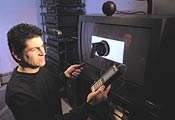TV Tweaks - Part One: House Calls Page 4
Sharpness This adjustment was important on sets made in the early 1980s but doesn't have much impact on current TVs, so it should be put at the lowest acceptable setting. Set the sharpness control too high, and you'll get ringing or ghosting at certain video frequencies, seen as faint white lines next to objects. Set it too low, and the decreased resolution will make the picture soft or even fuzzy. The technician will use test patterns to find the best balance between ghosting and loss of resolution.
TV: Same as It Ever Was Finally, we come to probably the best known part of calibration: grayscale adjustment. But to understand why it's so important, here's a quick history lesson.
The National Television System Committee, or NTSC, standards were devised in the 1950s to ease the transition to color TV by making sure that the new color signals would be compatible with existing black-and-white sets. To do this, the color information was essentially laid on top of the black-and-white signal. It was then up to your TV to separate these two signals (that's what a comb filter does) and properly decode them.
In the video world, gray is defined as equal amounts of red, green, and blue, with shades of gray produced by different levels of light intensity, from just barely lighter than black to peak white (peak white being gray at maximum intensity). As a result, you can't have an accurately reproduced color picture if the grayscale isn't set correctly.
A TV picture's light intensity is measured in IRE, a unit defined by the Institute of Radio Engineers. Black is 7.5 IRE, and peak white is 100 IRE. Transitions between 0 and 100 IRE are known as the grayscale.
Video white is also measured in kelvins of color temperature, and it ranges from 2,800 K (the orangeish white of a 60-watt light bulb) to 10,000 K (a bluish-white found in some high-intensity lamps). In 1953, the NTSC decided that the correct shade of white for our video system is about 6,500 K, which most closely resembles midday sunlight on a clear day.
 |
| The technician uses a color analyzer to measure color temperature and brightness on a high-output (100-IRE) window pattern. |
Why does this matter? Since the largest part of the video signal consists of black-and-white information, any deviation from the white-level reference of 6,500 K will bias all pictures toward that color. More specifically, since the studio monitors used while creating the source material are calibrated to 6,500 K, your TV mustbe set to the same temperature to accurately recreate the colors.
Tracking the Grayscale Because you can't adjust the grayscale through the user-accessible controls, this is where the ISF technician really earns his keep. Using a test DVD or a signal generator, he will bring up a "window" pattern - a gray rectangle in the center of the screen on a black background. There are two sets of adjustments available to calibrate color temperature, one for the low-IRE window and one for the high-IRE window.




























































